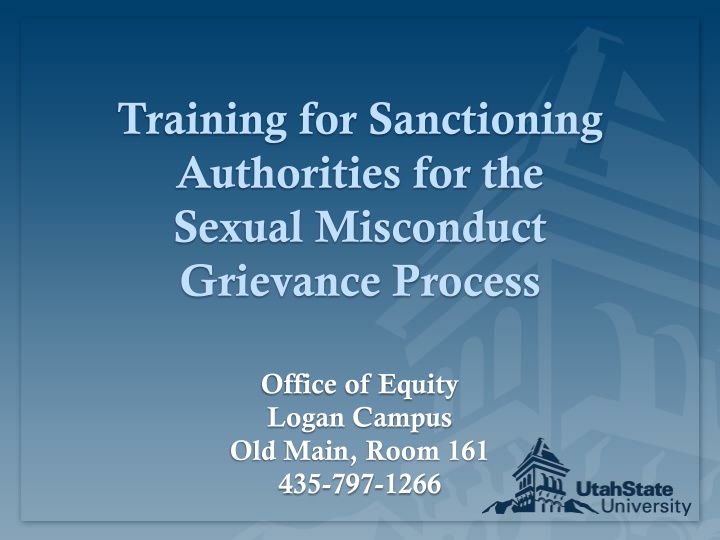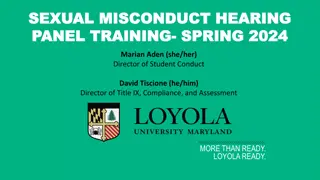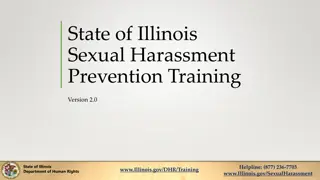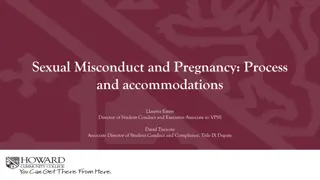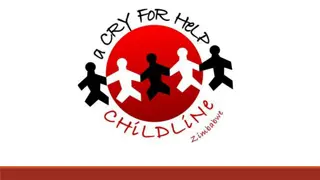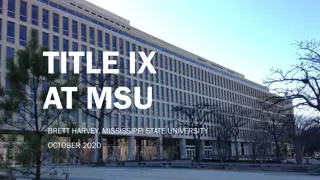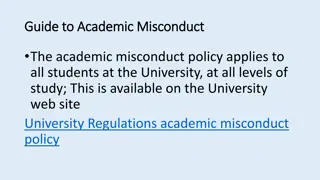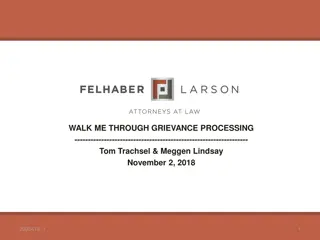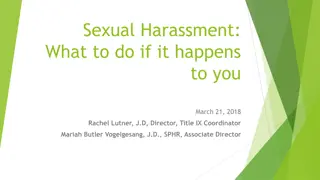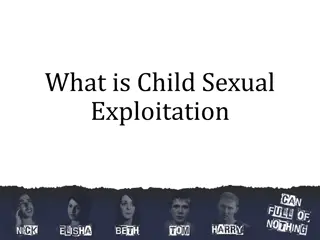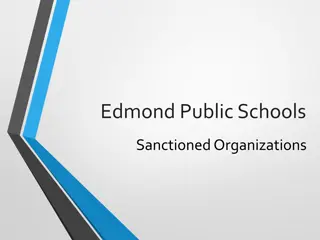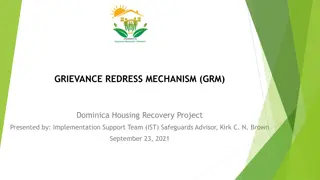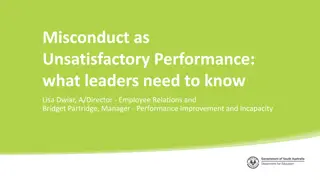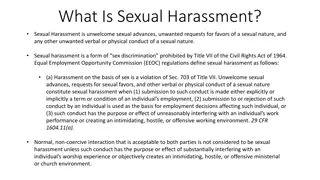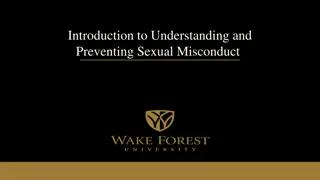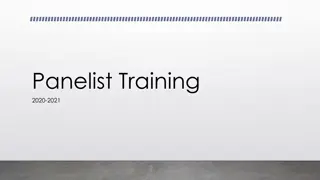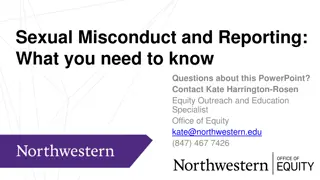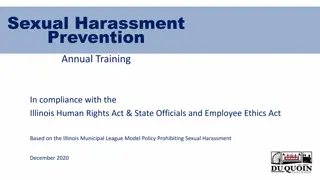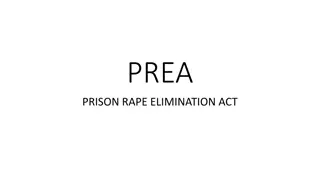Training for Sanctioning Authorities: Sexual Misconduct Grievance Process
This program offers comprehensive training to equip sanctioning authorities with the knowledge and skills required to handle sexual misconduct cases effectively. Participants will learn about the grievance process, equity principles, and best practices in addressing such sensitive issues on campus. The goal is to ensure fair and just outcomes while supporting a safe and inclusive environment for all individuals involved.
Download Presentation

Please find below an Image/Link to download the presentation.
The content on the website is provided AS IS for your information and personal use only. It may not be sold, licensed, or shared on other websites without obtaining consent from the author.If you encounter any issues during the download, it is possible that the publisher has removed the file from their server.
You are allowed to download the files provided on this website for personal or commercial use, subject to the condition that they are used lawfully. All files are the property of their respective owners.
The content on the website is provided AS IS for your information and personal use only. It may not be sold, licensed, or shared on other websites without obtaining consent from the author.
E N D
Presentation Transcript
Training for Sanctioning Authorities for the Sexual Misconduct Grievance Process Office of Equity Logan Campus Old Main, Room 161 435-797-1266
Presentation Topics Interim Sexual Misconduct Policy 339/339A/339B and related terms review Interim Sexual Misconduct Procedures 339/339A/339B related to sanctions
Ice Breaker Questions In what ways do you feel confident participating in the formal investigation process as a sanctioning authority? In what ways do you not feel confident participating in the formal investigation process as a sanctioning authority?
Your Role Your role is to serve as the sanctioning authority for either an employee or student Respondent
Title IX of the Education Amendments of 1972 Overview No person in the United States shall, on the basis of sex, be excluded from participation in, be denied the benefits of, or be subjected to discrimination under any education program or activity receiving Federal financial assistance. Discrimination based on sex is prohibited by Title IX Sexual harassment is a form of discrimination based on sex Sexual assault, relationship violence, and stalking are forms of sexual harassment
USUs Obligations Under Title IX Under Title IX, an institution must respond when it has actual knowledge of sexual harassment that occurred within the schools education program or activity. This includes locations, events, or circumstances over which the recipient exercised substantial control over the respondent and the context in which the sexual harassment occurred against a person in the United States.
Interim Sexual Misconduct Policies 339 (Title IX), 339A, and 339B Sexual Misconduct o Sexual Harassment o Sexual Assault o Relationship Violence o Sex-based Stalking Full definitions can be found in the Sexual Misconduct Policy and on sexualrespect.usu.edu Retaliation
Sexual Misconduct Policy Terms Sexual Harassment that creates a Hostile Environment Quid Pro Quo Sexual Harassment Unwelcome sex-based conduct Occurs when a University Employee Determined by a reasonable person Conditions the provision of a University aid, benefit, or service To be so severe, pervasive, and objectively offensive On a person s participation in unwelcome sexual conduct That it effectively denies a person equal access to the University s employment or education program or activity
Sex-Based Conduct Examples Verbal Behaviors Non-Verbal Behaviors Physical Behaviors Whistling Paying unwanted attention to someone Hanging around, standing too close, brushing up against Sexual comments or jokes Displaying sexually suggestive visuals Touching a person s clothing, hair, massaging neck/shoulders Asking personal questions and about someone s sex life Making facial expressions winking, licking lips, throwing kisses Hugging, kissing, patting or stroking Repeatedly asking someone out when the answer is No Sexual gestures with hands or body movements Touching or rubbing oneself sexually in view of others Referring to someone as hunk, doll, babe, honey, direct/indirect threats etc. Looking at a person up and down (elevator eyes) Sexual assault or rape Sending crude language via phone, email, etc. Sending explicit images via phone, email, etc.
Sexual Assault Penetration Sexual Touching Penetration of the vagina or anus, however slight, by a finger, object, penis, or tongue without a person s consent, or Nonconsensual or unwelcome touching under or over the clothing o Of the breasts, buttocks or groin, o Making another person touch any of these body parts, or o The emission of ejaculate onto the clothing or body of another person for the purpose of sexual gratification Oral penetration (mouth to genital contact or genital to mouth contact) without a person s consent
Consent Consent is an agreement to do the SAME THING at the SAME TIME in the SAME WAY
Consent Sexual assault occurs when at least one party does not consent to the sexual activity. Consent is an understandable exchange of words or actions, which indicate a willingness to participate in mutually agreed upon sexual activity. Consent can be withdrawn or modified at any time, as long as it is clearly communicated. Consent cannot be assumed based on silence, the absence of no or stop, the existence of a prior or current relationship, or prior sexual activity. Full definitions can be found in the Sexual Misconduct Policy and on sexualrespect.usu.edu
Consent There is no consent in the presence of coercion, incapacitation, force, or where the sexual activity violates state law relating to age of consent. Full definitions can be found in the Sexual Misconduct Policy and on sexualrespect.usu.edu
Relationship Violence Domestic Violence Violence or physical harm, or threat of violence or physical harm, or Any attempt, conspiracy, or solicitation to commit an offense involving violence or physical harm When committed by a current or former spouse, intimate partner, or intimate cohabitant against another or by a person against another person with whom they share a child in common Violence includes sexual assault (penetration) and sexual assault (sexual touching) Dating Violence Violence or physical harm, or threat of violence or physical harm, when committed by a person against their current or former intimate dating partner; or Any attempt, conspiracy, or solicitation by a person to commit an offense involving violence or physical harm against their current or former intimate dating partner Violence includes sexual assault (penetration) and sexual assault (sexual touching)
Stalking Engaging in a course of conduct directed at a specific person or persons based on sex that would cause a reasonable person to: Fear for their safety or for the safety of others, or To suffer substantial emotional distress Examples of Stalking o o Repeated and unwanted phone calls or texts A course of conduct is two or more acts, including, but not limited to, acts in which the stalker directly, indirectly, or through a third party, Follows, monitors, observes, surveils, threatens, intimidates, harasses, or communicates to or about a person, or interferes with a person s property by Telephone, mail, electronic communication, social media, or any other action, method, device, or means Following or spying Showing up somewhere without a legitimate reason to be there Posting information or spreading rumors online or by word of mouth Collecting information about patterns, job, classes, friends, etc. Using technology to track someone s movements or whereabouts Monitoring phone calls, emails, social media, etc. Contacting friends, family, work, etc. for information
Employee Designations Designated Confidential Resources Resource Connection Employees Reporting Employees* Disclosures will result in a report to the USU Title IX Coordinator Disclosures will not result in a report to the USU Title IX Coordinator Disclosures will not result in a report to the USU Title IX Coordinator Academic titles: Provosts, Deans, and Department Heads Administrative titles: Board of Trustees, President, Vice Presidents, Directors, Office of General Counsel attorneys, Office of Equity staff, Office of Student Conduct staff, Student Affairs staff, Fraternity and Sorority Life staff, Human Resources staff, Affirmative Action Advisory Council, and USU Police Officers Athletic titles: Directors, NCAA and NJCAA coaches, and club sports coaches Campus Security Authorities Supervisors of employees Counseling and Psychological Services (CAPS) USU Eastern Student Counseling Sexual Assault and Anti- Violence Information (SAAVI) Office Student Health & Wellness Center USU Psychology Community Clinic USU Marriage and Family Therapy Clinic USU Employee Assistance Program All other full-time and part- time employees Only these student employees: o A-team members (orientation) o Athletics department student employees o Classroom facilitators o Connections peer mentors o Graduate Assistants o Undergraduate Teaching Fellows
Grievance Process Overview The Grievance Process includes: Informal Resolutions Formal Investigations University-driven Investigations
USU Department Roles in Title IX Grievance Process Hearing Panel o Facilitate live hearings for formal investigations o Decide whether a policy violation occurred Office of Student Conduct & Community Standards o Determine sanctions for student respondents Respondent s Supervisor (with HR) o Determine sanctions for staff respondents Provost s Office o Determine sanctions for faculty respondents
Initiating the Grievance Process Whocan request an Informal Resolution or a Formal Investigation? Under 339 (Title IX): An individual that experienced sexual misconduct (Claimant) while participating in a university employment or educational program or activity from an individual connected to USU (Respondent) Employment or Education Program or Activity. Locations, events, or circumstances in the United States in which the University has substantial control over both the Respondent and the context in which the Sexual Misconduct occurs. Employment or Education Program or Activity includes all off-campus buildings owned or controlled by a recognized student organization and includes the University s computer and internet networks and digital platforms.
Whocan request an Informal Resolution or a Formal Investigation? Under 339A/339B: An individual that experienced sexual misconduct off-campus and there are continuing adverse effects on, or creates a hostile environment for, students, employees, or third parties in an employment or education program or activity, including that which results in a criminal charge or conviction and the Respondent is connected to USU In determining whether alleged sexual misconduct that occurred outside an Employment or Education Program or Activity likely has continuing adverse effects or creates a hostile environment, the University will consider: 1) the severity of the alleged conduct; 2) the risk of ongoing harm; 3) whether both parties; are members of the University community; 4) the impact to an Employment or Education Program or Activity; and 5) whether the conduct was part of a series of actions that occurred both in and outside of an Employment or Education Program or Activity.
Formal Complaint In order to initiate the grievance process the Claimant must: Complete a jurisdiction form If there is jurisdiction to proceed, the Claimant must sign the formal complaint for an informal resolution or formal investigation
Formal Investigation Process
Conducting an Investigation The investigator will conduct a fair and impartial Grievance Process, free of Conflicts of Interest, Bias, and discrimination, in which both parties are treated as equitably as possible. Both parties have an equal opportunity to present witnesses and other inculpatory and exculpatory evidence.
Record Evidence Acquired from the Parties The Claimant and Respondent may provide evidence to support the allegations raised in the formal complaint. Incident Report A report of alleged sexual misconduct filed online, via email, by phone, by mail, or in-person to the Office of Equity, Title IX Coordinator, or a reporting employee. Formal Complaint A signed document that indicates the University will proceed with a formal investigation of sexual misconduct. A formal complaint may be signed by the claimant or by the Title IX Coordinator. Notice of Allegations A written document that notifies both claimant and respondent that a formal complaint of sexual misconduct was been filed and outlines the allegations. Respondent Interview - The Respondent interview is a recorded interview between the Respondent and the Office of Equity investigator regarding the allegations raised in the formal complaint. Claimant Interview The Claimant interview is a recorded interview between the Claimant and the Office of Equity investigator regarding the allegations raised in the formal complaint.
Record Other Evidence This is evidence obtained from parties other than the claimant or respondent. Response(s) to the Record The claimant and respondent may file a written response to the record. Preliminary Report Issued The preliminary report outlines the procedural history of the case from the formal complaint to the final report. The preliminary report also summarizes the investigation and outlines all the relevant evidence gathered during the investigation, both inculpatory and exculpatory, and considers written responses to the record. The preliminary report includes the alleged policy violation(s) and a range of possible sanctions for each alleged violation in the event the hearing panel finds the Respondent to have violated USU policy. However, the preliminary report does not reach a determination about whether Respondent violated USU policy. Response(s) to the Preliminary Report The claimant and respondent may each file a written response to the preliminary report. Final Report The final report has all the information from the preliminary report and also includes relevant information from responses to the preliminary report.
Final Report Procedural History Alleged Policy Violations Range of Possible Sanctions Summary of the Investigation Written Responses to the Record
Hearing Basics, Pt. 1 Prior to the live hearing, the Office of Equity investigation gathers evidence, interviews parties and witnesses, and allows for a written response by the parties to both the record evidence and preliminary investigation report. The Office of Equity then issues a final report, summarizing the relevant evidence gathered in the investigation. The live hearing is the first and primary determination phase of the sexual misconduct grievance process as to whether or not there is a preponderance of the evidence of a policy violation
Hearing Basics, Pt. 2 The hearing is scheduled within 25 days of the issuance of the final investigation report The hearing allows parties to present their cases and to cross-examine one another (through their process advisors), The hearing panel determines whether a policy violation occurred by a preponderance of the evidence, and, The hearing is recorded. The sanctioning authority is expected to attend and observe the hearing. If they absolutely cannot attend, they can review the recording.
Hearing Attendees The hearing shall be closed to the general public and only the following individuals will be allowed into the hearing room: Hearing Panel Members; Hearing Officer; University Legal Counsel; Claimant; Claimant's Process Advisor and/or Support Person; Respondent Respondent s Process Advisor and/or Support Person; A University law enforcement officer; The Title IX Coordinator or their designee and the Office of Equity investigator; The Sanctioning Authority or their designee; Witnesses, including Expert Witnesses. Witnesses will be present only at the time of their testimony and will not be permitted to hear the testimony of other Witnesses.
First Requirements of Hearing Panel (If Finding) Within 5 business days of the hearing, the hearing panel shall issue a preliminary findings letter to the sanctioning authority and the Title IX Coordinator, outlining the policy violations the hearing panel has found Respondent to have committed, if any. The hearing panel will reach a decision as to whether the Respondent violated this policy by a preponderance of the evidence, and shall issue a written determination.
Requirements of Sanctioning Authority Each party may submit a 5-page statement regarding sanctions to the sanctioning authority within 5 business days of the date of the preliminary findings letter. Upon receipt of preliminary findings letter, the sanctioning authority shall issue a sanctions letter outlining the sanction that should be ordered for each of the policy violations the hearing panel has found the Respondent to have committed.
Sanction The sanction shall be proportionate to the policy violation(s), taking into account the parties statements on sanctions, if any, and mitigating, aggravating, and compounding factors
Appeals Basics Within 10 business days of the date the determination and/or the sanction are issued, any party may file a written appeal of the hearing panel s determination and/or the sanction with the hearing officer The appellate panel can dismiss the appeal if it does not meet the standard for appeal and/or it was not timely filed The non-appealing party can file a written response to the appeal An appeal is performed on the record i.e., there is no hearing.
Potential Outcomes of an Appeal Affirm the hearing panel s determination or sanction Modify the hearing panel s determination or sanction Remand the determination or sanction to the hearing panel (appropriate where evidence was not available to the hearing panel) Overturn the determination if the determination was based on a procedural error(s) and the error(s) resulted in prejudice to the appealing party. Overturn the sanction if the sanctioning authority had a conflict of interest or bias that affected the sanction and/or the sanction is not proportionate to address the policy violations Respondent is found to have committed.
Sanction-only Process If the parties reach an earlier resolution agreement that Respondent admitted to a policy violations, but the parties do not reach an agreement regarding sanctions, the sanction process will proceed. The earlier resolution facilitator shall notify the sanctioning authority and the Title IX Coordinator within 5 business days of the agreement that sanctions should proceed. The Office of Equity will immediately electronically share the record with the sanctioning authority and the Title IX Coordinator.
Sanction-only Process A hearing will be held for the purpose of the sanctioning authority asking the parties questions related to the sanction. The parties may submit statements to the sanctioning authority addressing the the mitigating, aggravating, and compounding factors. The sanctioning authority will then issue a sanction letter, including the mitigating, aggravating, and compounding factors. The sanction may be appealed.
Avoiding Bias Don t let a party s gender or race influence your beliefs about the case, the evidence, their credibility, or the appropriate sanction. Those things only matter as an element of discrimination. A party s account should not be more or less believed because of their race, gender, religion, etc. Focus on what the evidence (including the parties and witnesses statements) tells you, not what you believe should happen in a situation like this or what you know to have occurred in other similar situations.
Avoiding Bias Ask yourself: Have I reached this conclusion, decision, or sanction based on the evidence, or based on something else? o Would I have come to this same conclusion if the Claimant or Respondent were a different race or gender?
Avoiding Bias o Am I making this decision because of bias towards the Claimant or the Respondent, or because of Claimants or Respondents in general? If there is a concern that your decision is based on something other than the finding and the evidence, go back and look again.
Conflict and Bias Check As a Sanctioning Authority you will be asked: At this stage, could you please identify whether you have either personal or professional ties to the Respondent, or personal or professional ties to the Claimant, that could affect your ability to participate in the hearing process with objectivity. If your answer to the first question is yes, you should be honest about that and admit that you cannot serve impartially.
Thank You! Office of Equity Logan Campus Old Main, Room 161 435-797-1266 Senior Prevention Specialist Emmalee Fishburn, emmalee.fishburn@usu.edu Prevention Specialists Jodie Goodman, jodie.goodman@usu.edu Mary Reid, mary.reid@usu.edu Director Alison Adams-Perlac, alison.adams-perlac@usu.edu Supportive Measures Specialist Rachel Bernardo, rachel.bernardo@usu.edu Katie Freeman, katie.freeman@usu.edu Title IX Coordinator Hilary Renshaw, hilary.renshaw@usu.edu Staff Assistant Carolyn Baker, carolyn.baker@usu.edu Senior Equity Investigators Steven Rammell, steve.rammell@usu.edu equity.usu.edu sexualrespect.usu.edu Case Coordinator Kimiko Smith, Kimiko.smith@usu.edu
